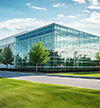John Thornton has described the coming wave of lunar industrialization as part of a trillion-dollar private space economy. His company delivers payloads to the Moon and builds its products in Pittsburgh. He sat down with Area Development to discuss site selection on the Moon, Earth-based supply chains, and why his town has an edge in the space economy.
Area Development: In terrestrial site selection, proximity to infrastructure, resources, and talent drives decisions. What makes a location on the Moon strategically valuable?
John Thornton: When you go to the Moon, it's basically going to a new world. You want to set up near resources so you can live off the land. Right now, the most important resources are sunlight and water ice.
The Moon’s equator only gets 14 days of light, 14 days of darkness. But at the poles, some areas receive near-continuous sunlight—great for solar power. Shadowed craters near the poles harbor water ice, which can be turned into drinking water, oxygen, or split into hydrogen and oxygen for rocket fuel.
You also want a flat, safe landing area. And if you could find a cave near sunlight and water ice, that would be ideal—it offers natural shelter from radiation and temperature extremes.
AD: You’ve said space will soon be a trillion-dollar industry. How does that growth translate into real-world activity?
Thornton: The global space industry just hit $600 billion. It’s expected to reach $1 trillion by 2040—or even 2035. Most of that today involves satellites—for imaging, communications, internet, TV, and radio. That’s helping drive down launch costs, which is opening new frontiers like the Moon.
The next phase is about building reliable, routine access to the Moon. Then comes resource scouting and eventually extraction at scale—for use in space and possibly back on Earth.
AD: Back on Earth, where are the key manufacturing hubs for the space industry?
Thornton: The major U.S. hubs are Texas, California, Colorado, Florida, and Ohio. These regions often develop around NASA centers or Space Force sites—they create a strong space culture and innovation ecosystem.
Pittsburgh is more of an exception. It doesn’t have as much traditional space activity, but that’s an opportunity. We’re tapping into the region’s strengths in AI and robotics to bring new technology to space.
AD: What gives your Pittsburgh facility an advantage?
Thornton: Pittsburgh still has a strong advanced manufacturing base. Our lander is 99 percent sourced for machined parts in the area. We’ve also built a strong supply chain for avionics and other components.
We have a class 10K clean room where we build our landers. It’s standard in aerospace but unique for Pittsburgh. And we’re fueled by top-tier tech talent from Carnegie Mellon, Pitt, and Penn State.

AD: Does this point to a shift—where tech acumen is becoming as critical as traditional aerospace skills?
Thornton: They go hand in hand. New tech pushes manufacturing to its limits. Advanced components need advanced methods. So tech development and manufacturing have to be co-developed.
AD: Let’s return to that ideal Moon site—near sunlight, ice, and a cave. What does development look like there?
Thornton: Humans would likely live underground, in a cave, for protection. Robots would operate on the surface. Power would come from solar panels placed on peaks of persistent light. Over time, nuclear may play a role, but solar will likely dominate early due to cost and simplicity.
Robots would extract water ice from shadowed craters—using reflected light, power cables, microwaves, or cold fingers. That water would be stored and converted into fuel to support travel to lunar orbit, Earth, or even Mars. The Moon becomes a gateway to the rest of the solar system.
AD: Would launching from the Moon require a major infrastructure build?
Thornton: The Moon’s gravity is one-sixth of Earth’s, and it has no atmosphere. So you don’t need aerodynamic vehicles, and you don’t need as much fuel. You could launch from a crater. It’s very different from launching here—and far more efficient.
AD: How soon could we see infrastructure or mining operations on the Moon?
Thornton: Right now, we’re focused on reliable delivery through NASA’s Commercial Lunar Payload Services (CLPS) program. That success will spur demand—for science, then for commercial activity. If there’s political will, infrastructure could begin this decade. Mining and large-scale use of lunar resources is likely a few decades out—but we need to start now, and some of that work is already underway.
AD: Is the U.S. ahead or behind internationally?
Thornton: I believe China is ahead. They’ve had more successful Moon landings in the last decade, including the first on the far side. They’re discovering materials we didn’t know existed and are moving aggressively on infrastructure and resource exploration.
The U.S. has strong pieces in place, but CLPS is funded at around $250 million annually, a small slice of NASA’s $25 billion budget. We need more missions, bigger robots, and a real push for permanent infrastructure.
AD: Is adaptability still key in lunar manufacturing?
Thornton: Absolutely. Each mission teaches us something new. Until we reach routine, commercial lunar operations, we need flexible, adaptable facilities.
But we’re moving in that direction. You’ve seen it with rockets and satellite constellations. The Moon is next. Long-term manufacturing at scale is coming.



